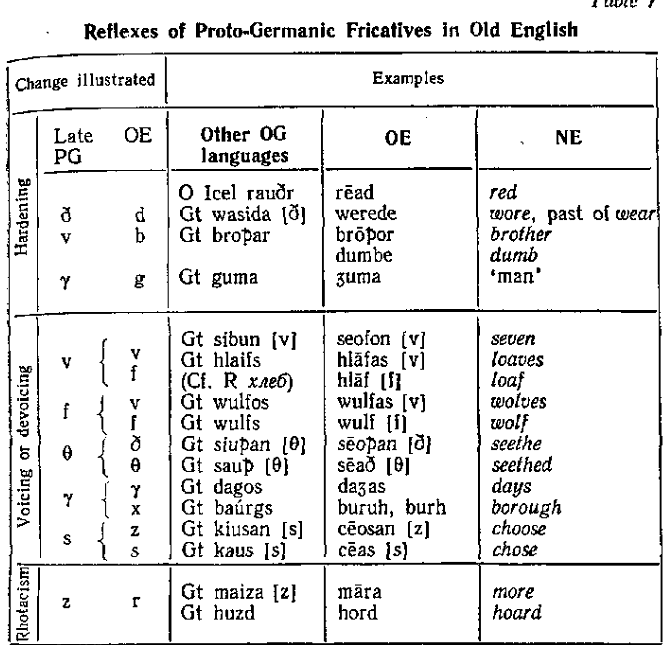
- •1. Linguistic features of Germanic languages: vowels.
- •Indo-European short o and a appear as short a:
- •3. Linguistic features of Germanic languages: consonants.
- •4. Me phonetics: vowel (reduction, shortening/lengthening,
- •5. The Earliest Period of Germanic History
- •6. Me phonetics. Developm. Of Old English diphthongs inМe
- •7.Basic grammatical features of Germanic languages. Runes
- •8. The Great vowel shift. R
- •Vowel Shift was a major change in the pronunciation of Germanic languages. It represented a change in the long vowels.
- •9. Chronological division in the history of English. Short survey of periods.
- •10. New English Phonetics: loss of unstressed –e, the change of –er into –ar, a into ǽ. Rise of new phonemes.
- •11. Old English. Historical background.
- •3 Gramm. Categories:
- •12. Ne phonetics: the 17th century changes.
- •13. Old and Modern Germanic languages.
- •14. Middle and New English noun: morphological classification, grammatical categories.
- •15. Old English Dialects and Written Records.
- •16. Origing of modern irregular noun forms
- •17. Oe phonetics: vowels ( breaking, diphtongization, palatal mutation, shortening/lengthening).
- •18. Me & ne adjective and pronoun
- •19. Oe phonetics: consonants (voicing of fricatives, rhotasism, palatilizatin, metathesis, loss of consonants in certain position).
- •20. Middle and New English adverb, Numeral, the Article.
- •21. Oe Verb. Grammatical categories and morphologiacal classification.
- •22 Morphological classification of verbs in me and ne
18. Me & ne adjective and pronoun
Adjective:
-greatest inflectional losses; totally uninflected by end of ME period; loss of case, gender, and number distinctions
-distinction strong/weak lost; causes in loss of unstressed endings, rising use of definite and indefinite articles
-comparative OE -ra > ME -re, then -er (by metathesis), superlative OE -ost, -est > ME -est; beginnings of periphrastic comparison (French influence): swetter/more swete, more swetter, moste clennest; more and moste used as intensifiers
Indefinite form of the adjective (XII – XIII c.)
sing. pl.
f. m. n.
Nom. -,-e - - -e
Gen. -re -es -es -re
Dat. -re -en -en -en
Acc. -,-e -en - -e
Definite form of the adjective (XII – XIII c.)
sing. pl.
f., m., n.
Nom. -e -en
Gen. -en -re
Dat. -en -en
Acc. -e,-en -en
Pronoun :
preservation of gender, number, case, and person categories;
merger of dative and accusative into single object case;
dual number disappeared.
- use of 2nd person plural (ye) to address one person as polite form (French influence), eventual loss of singular forms in 18th c.
-First-person singular: ich/I; loss of unstressed final consonant led to first person singular form I (pronounced as the 'i' in "kid");
-feminine third person singular, heo/sche, -- [š] appeared first in North and East Midlands and allowed distinction from masculine forms
-Third person plural, he, hem, here; then borrowing of pronouns from Old Norse (nom. þeir, dat. þeim, gen. þeira> they, them, their) to prevent confusion with other forms, especially in the singular and feminine
19. Oe phonetics: consonants (voicing of fricatives, rhotasism, palatilizatin, metathesis, loss of consonants in certain position).
After the changes under Grimm’s Law and Verner’s Law PG had the following two sets of fricative consonants:
Voicless (f, θ, x,s)
Voiced (v, ð, y, z).
Voicing – voiceless cons becomes voiced.

Grimm’s Law (consonant shift). Grimm’s Law had 3 acts:
1. [p], [t], [k] -> voiceless fricatives [f], [th], [x]; (pater-fadar)
2. [b], [d], [g] -> voiceless stops [p], [t], [k]; (duo-twai)
3. aspirated [bh], [dh], [gh] ->voiced [b], [d], [g]. (bhratar-druder)
Verner’s Law explains some correspondences of consonants which contradicted Grimm’s. All the early PG voiceless fricatives [f,,h], s, became voiced between vowels if the preceding vowel was unstressed: f → b, → d, s → z and h → g.
Palatalization
After the palatal consonants [k’], [sk’] and [j] short and long [e] and [æ] turned into diphthongs with a more front close vowel as their first element, e.g. OE scæmu > sceamu (NE shame).
Loss of consonants in some positions
Nasal sonorants before fricative consonants; (OHG fimf – OE fīf (NE five)).
Loss of [j] (cild).cons lost->vowel lengthened.
Metathesis – phonetic change (2 sounds exchange their places). (rinnan-irnan)
